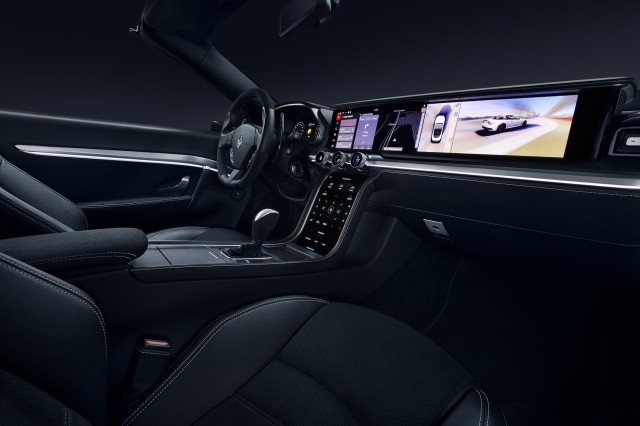Harman shows digital dashboard with 5G connectivity at CES
 |
| Harmon digital cockpit revealed at CES 2018 |
The 2018 Consumer Electronics Show is full of futuristic vehicle technology and connected-car solutions, but Harman is differentiating itself by bringing 5G connectivity to the automotive world. The company revealed its digital cockpit and 5G-ready telematics solution and announced a "leading European automaker" will be first to implement the 5G connectivity.
The cockpit follows a familiar design trend of late: big screens that stretch across the dashboard. The digital cockpit, shown with a Maserati interior, spans from the gauge cluster to the passenger door and has the capability for steering wheel controls, haptic feedback, and traditional dials or knobs. Harman's new Bixby personal assistant will be integrated and will allow users to complete tasks by voice, touch, gestures, and context-based triggers. Harman claims that the system is very intuitive and provides a safe way to interact with information and entertainment via a projection mode for services and apps from the user's smartphone. The digital cockpit also boasts an Internet of Things (IoT) ecosystem to improve connectivity and lower vehicle weight, presumably with fewer onboard components.
Harman described premium and entry-level different digital cockpits. The premium unit, on display in the photos, weaves a driver's connected presence through the company's Ignite platform. Drivers and other users can personalize the entire cockpit with virtual personal assistants, portable profiles, augmented reality, and more. The Android operating system can be integrated into all four screen displays as well.
The particular digital cockpit shown doesn't apply to just one car or segment, either. Harman said the cockpit is totally scalable, and like today's smartphones, offers a developer-friendly open ecosystem.
 |
| The dash is very customizable |
As for the 5G connectivity, Harman and Samsung–which now owns Harman–are jointly developing a modular approach to the advanced telematics system, and they intend to deliver the first multi-band 5G-capable conformal antenna. The telematics system should provide speeds up to 1 Gb/second of bandwidth, which is 100 times quicker than current 4G LTE networks. That will allow for high-resolution streaming and ultra-quick cloud-based applications. The modular telematics control unit will currently support 4G LTE CAT 16 connectivity and will switch to 5G when it becomes available.
This comes before 5G is even available. AT&T has announced that it intends to launch mobile 5G service in a dozen markets by late 2018, and Verizon has plans for 11 markets by midyear. Fixed hotspots should be available in 2019, and the first 5G-enabled smartphones should be here by 2020. As you can see by this announcement, cars will be there to connect to the 5G networks right away.
But, it wouldn't be CES without mention of a self-driving car. Samsung and Harman also announced its DRVLINE platform, an open-source and modular platform for Level 3, 4, and 5 self-driving cars. Ahead of more research on the autonomy front, the companies will bring a forward-facing camera to market capable of enabling lane-departure warning, adaptive cruise control, forward collision warning, and pedestrian warning. The new unit will launch this year. Motorauthority
